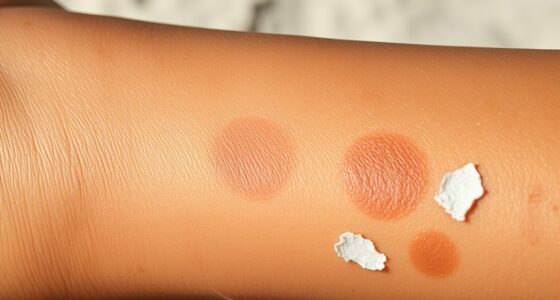To achieve glowing skin, focus on nutrient-rich foods packed with vitamins, minerals, and antioxidants. Incorporate vibrant fruits and vegetables like red bell peppers, carrots, and berries for their collagen-boosting properties. Don't forget fatty fish like salmon and avocados, which provide healthy fats for hydration and elasticity. Keeping hydrated with water and water-rich foods like cucumbers and watermelon is essential, too. Probiotic-rich foods such as yogurt support gut health, also influencing your skin's appearance. With these tips, you're on your way to a radiant complexion, and there's more to uncover for that perfect glow.
Key Takeaways
- Incorporate vitamin C-rich foods like red bell peppers and strawberries to boost collagen production for radiant skin.
- Consume healthy fats from avocados and fatty fish to enhance skin elasticity and hydration.
- Stay hydrated by drinking water and eating water-rich foods such as cucumbers and watermelon for improved skin moisture.
- Include antioxidant-rich options like berries and dark chocolate to combat oxidative stress and promote a youthful glow.
Nutrient-Rich Foods for Skin
Eating nutrient-rich foods like red bell peppers, carrots, and fatty fish can greatly enhance your skin's health and appearance.
Red bell peppers are a powerhouse of vitamin C, providing over 200% of your daily value in just one cup. This essential vitamin supports collagen production, helping to protect your skin from UV damage and maintain its firmness.
Carrots, packed with beta-carotene, convert to vitamin A in your body, improving skin health and tackling acne issues. A medium carrot offers more than 200% of your daily value, making it a must-have for a glowing complexion.
Fatty fish like salmon and mackerel are rich in omega-3 fatty acids, which preserve collagen and boost skin elasticity, keeping it hydrated and youthful. Incorporating these superfoods into your diet can markedly improve your skin's moisture levels.
Additionally, avocados, loaded with healthy fats and vitamin E, promote flexibility and shield your skin against sun damage.
The Power of Antioxidants

Antioxidants play an essential role in protecting your skin from oxidative stress and the damaging effects of free radicals, which can accelerate aging and contribute to various skin conditions. By consuming foods rich in antioxidants, you can improve the resilience of your skin cells, making them more robust against environmental damage.
Incorporating vibrant fruits and vegetables into your diet is essential for achieving healthy skin. Berries, dark chocolate, and green tea are excellent sources that help combat signs of aging, such as wrinkles and fine lines.
Vitamin C, found in citrus fruits and bell peppers, is particularly important for collagen production, which maintains your skin's elasticity and firmness.
Regularly enjoying a variety of these antioxidant-rich foods can greatly enhance your skin health. Not only do they help to neutralize free radicals, but they also promote a radiant, glowing complexion.
Essential Fatty Acids

Essential fatty acids, like omega-3s and omega-6s, are crucial for keeping your skin hydrated and elastic.
You can find these healthy fats in foods like fatty fish, walnuts, avocados, and olive oil.
Including these options in your diet can greatly enhance your skin's overall health and glow.
Omega-3 Rich Foods
Including omega-3 rich foods in your diet can transform your skin, enhancing its elasticity and hydration while reducing fine lines and wrinkles.
These essential fatty acids are fundamental for maintaining skin health and combating inflammation, making them a key component in any skincare routine.
Here are some excellent sources of omega-3 fatty acids to take into account:
- Fatty fish: Salmon, mackerel, and sardines are packed with omega-3s that support skin elasticity and hydration.
- Walnuts: These nuts provide a plant-based source of omega-3s, helping to improve moisture retention and protect against oxidative stress.
- Flaxseeds: Ground flaxseeds are another great plant-based source, contributing to overall skin health and collagen production.
- Chia seeds: Rich in omega-3s, they're perfect for adding to smoothies or oatmeal for a skin boost.
Incorporating these foods into your diet can play a significant role in enhancing your skin's health and vibrancy.
Healthy Fat Sources
Healthy fats are essential for your skin, providing the necessary nutrients to maintain hydration, elasticity, and overall health. Including healthy fat sources in your diet can greatly enhance skin hydration and elasticity.
Fatty fish, like salmon and mackerel, are rich in omega-3 fatty acids, which help keep your skin thick, supple, and moisturized while reducing inflammation from conditions such as acne.
Walnuts are another great option; they provide essential fatty acids, including omega-3 and omega-6, promoting skin barrier function and hydration. Plus, they contain zinc, which is vital for skin repair.
Avocados are packed with monounsaturated fats that improve skin flexibility and moisture. They also boast vitamins E and C, which protect against oxidative stress.
Olive oil is an excellent choice too, as it's rich in monounsaturated fats and antioxidants, supporting skin hydration and preventing moisture loss.
Hydration and Skin Health

Staying properly hydrated is key to maintaining your skin's elasticity and youthful glow. Your skin cells are made up of about 64% water, so adequate hydration is essential for optimal skin health. When you don't drink enough water, dehydration can lead to roughness and fine lines. Aim for at least 8-10 cups of water daily to keep your skin looking its best.
Incorporating water-rich foods into your diet can also considerably improve skin moisture:
- Cucumbers
- Watermelon
- Strawberries
- Celery
Herbal teas, for instance, are about 99% water and deliver antioxidants that further enhance your skin health.
Regular hydration practices not only help with overall hydration but also improve blood circulation, allowing crucial nutrients to reach your skin cells. This leads to a radiant and healthy complexion.
Gut Health and Skin

Your gut health plays an essential role in the appearance of your skin.
By incorporating fiber-rich foods and probiotics into your diet, you can support a balanced gut microbiome that promotes clearer and healthier skin.
Understanding this gut-skin connection can help you make better food choices for a glowing complexion.
Gut Microbiome Impact
Research consistently shows that the gut microbiome plays an essential role in skin health, influencing everything from inflammation levels to the skin's natural barrier function. A balanced microbiome can markedly reduce inflammation, leading to improved skin conditions like acne and eczema.
To support your gut health and enhance your skin's radiance, consider incorporating the following foods into your diet:
- Fruits and vegetables: High in fiber, they promote a diverse gut microbiome.
- Whole grains: They provide essential nutrients that support gut balance.
- Probiotic-rich foods: Think kimchi, yogurt, and sauerkraut for gut health.
- Fermented foods: These can enhance nutrient absorption and improve skin hydration.
Probiotics and Skin Health
How can probiotics transform your skin health and boost your glow? By balancing your gut microbiome, probiotics play an essential role in enhancing your skin's overall appearance. When you include foods like yogurt and kimchi in your diet, you can help reduce inflammation, which is often a key factor in various skin conditions such as acne and eczema.
A healthy gut environment not only improves hydration but also strengthens your skin's barrier function, making it more resilient to environmental stressors. This means your skin can better maintain its moisture and fend off irritants that can cause breakouts or dullness. Plus, a well-functioning gut microbiome promotes better skin texture and tone, reducing the appearance of blemishes and ensuring a smoother complexion.
Moreover, probiotics can support your immune system, minimizing inflammatory responses that may impact your skin health. By regularly consuming probiotic-rich foods, you're not just nurturing your gut; you're also taking essential steps towards achieving that radiant, glowing skin you desire.
Fiber-Rich Foods
Building on the benefits of probiotics, fiber-rich foods also play a significant role in maintaining gut health and enhancing your skin's radiance. When you include these foods in your diet, you're not just supporting digestion; you're also paving the way for overall skin health.
A balanced gut microbiome is essential for achieving clear skin and reducing skin inflammation.
Incorporate these fiber-rich foods to boost your gut health:
- Fruits: Berries, apples, and bananas
- Vegetables: Spinach, broccoli, and carrots
- Legumes: Lentils, chickpeas, and beans
- Whole Grains: Oats, quinoa, and brown rice
These foods help enhance nutrient absorption, delivering essential vitamins and minerals to your skin cells. This not only helps promote a glowing complexion but also aids in detoxifying your body, keeping it free from harmful substances.
Plus, a fiber-rich diet can help regulate blood sugar levels, preventing spikes that may lead to acne and other skin issues.
Collagen-Boosting Foods

To achieve glowing skin, you should load up on collagen-boosting foods that enhance your skin's elasticity and hydration. Start by incorporating plenty of vitamin C-rich foods like strawberries, oranges, and bell peppers, as vitamin C is vital for collagen synthesis.
Bone broth is another nutrient-dense option; it contains collagen and amino acids that support skin elasticity.
Don't forget about fatty fish, like salmon and mackerel. These provide omega-3 fatty acids that help maintain your skin's collagen structure and reduce inflammation, which is key for maintaining a youthful appearance.
Foods high in antioxidants, such as berries and tomatoes, also play a significant role. They protect collagen from oxidative damage, promoting healthier skin overall.
Leafy greens, like spinach and kale, are essential as well. They not only contribute to collagen production but also improve your overall health due to their rich vitamin A and C content.
By incorporating these collagen-boosting foods into your diet, you're not just enhancing your skin health but also investing in your long-term well-being.
Anti-Inflammatory Choices

Incorporating anti-inflammatory choices into your diet can greatly enhance your skin's clarity and radiance. By focusing on foods rich in antioxidants, omega-3 fats, and other beneficial compounds, you can effectively combat inflammation and promote glowing skin.
Consider adding these anti-inflammatory foods to your meals:
- Fatty fish (like salmon and mackerel) for omega-3 fats that manage skin conditions and reduce inflammation.
- Leafy greens (such as spinach and kale) packed with vitamins and minerals that support skin health and enhance clarity.
- Nuts (particularly walnuts and almonds) to provide healthy fats and vitamin E, essential for maintaining skin barrier function.
- Green tea and dark chocolate, rich in polyphenols, to improve skin hydration and elasticity while protecting against sun damage.
Colorful Fruits and Vegetables

Colorful fruits and vegetables bring a wealth of nutrients that can greatly boost your skin's health and radiance. Packed with antioxidants and vitamins, these vibrant foods provide essential elements for maintaining youthful skin. For instance, red bell peppers pack more vitamin C than oranges, which is vital for collagen production and protecting your skin from UV damage.
Incorporating dark leafy greens like spinach helps combat oxidative stress and supports skin repair. Berries, such as strawberries and blueberries, are rich in anthocyanins and vitamin C, boasting impressive anti-inflammatory properties that enhance skin texture and reduce signs of aging. Tomatoes, loaded with lycopene, offer protection from sun damage, especially when consumed with healthy fats.
Here's a quick reference guide to some colorful fruits and vegetables and their skin benefits:
| Fruit/Vegetable | Key Nutrients & Benefits |
|---|---|
| Red Bell Pepper | High in Vitamin C, boosts collagen |
| Spinach | Rich in Vitamins A, C, and E, supports repair |
| Berries (Strawberries, Blueberries) | Antioxidants, anti-inflammatory properties |
Skin-Nourishing Seafood

Skin-nourishing seafood plays an important role in enhancing your complexion and overall skin health. Incorporating seafood into your diet can provide you with essential nutrients that promote skin hydration, repair, and a youthful appearance. Here are some key seafood options to evaluate:
- Fatty fish like salmon, mackerel, and sardines are packed with omega-3 fatty acids, significant for maintaining skin thickness and reducing inflammation.
- Shellfish, including shrimp and oysters, are rich in zinc, which helps regulate skin inflammation and supports healing.
- Trout also boasts omega-3 fatty acids, aiding in skin hydration and managing conditions like psoriasis.
- Bone broth, derived from simmered animal bones, is loaded with collagen and gelatin, both crucial for skin elasticity and hydration.
Frequently Asked Questions
What Foods to Eat to Make Skin Glow?
To make your skin glow, you should eat antioxidant-rich berries, fatty fish for hydration, avocados for moisture, sweet potatoes for a natural sunblock effect, and nuts for essential vitamins. These foods nourish and protect your skin.
What Foods Give You Perfect Skin?
To achieve perfect skin, you should eat fatty fish for hydration, berries for antioxidants, sweet potatoes for beta-carotene, nuts for healthy fats, and green tea for its protective properties. Your skin will thank you!
What to Drink to Make Your Skin Glow?
While sugary sodas dull your skin, fresh vegetable juices and green tea hydrate and rejuvenate it. Drinking 8-10 cups of water daily, along with coconut water, boosts your glow and keeps your skin vibrant.
What Foods to Eat to Lighten Your Skin?
To lighten your skin, you should eat foods high in vitamin C, antioxidants, and beta-carotene. Incorporate citrus fruits, tomatoes, carrots, and leafy greens into your diet for a healthier, brighter complexion that shows radiance.
Is Eating a Variety of Foods Essential for Achieving Glowing Skin?
Eating a variety of foods is essential for achieving glowing skin. To enhance your skin’s radiance, be sure to eat this amazing vegetable. Its high levels of antioxidants and vitamins can help improve your skin’s appearance and promote a healthy complexion. Incorporating diverse foods is key to achieving beautiful, radiant skin.
Conclusion
To truly reveal your skin's glow, think of your plate as a canvas.
By choosing nutrient-rich foods, antioxidants, and hydrating options, you're painting a masterpiece of health from the inside out.
Don't forget the power of essential fatty acids and collagen-boosting selections to keep your skin youthful and vibrant.
Remember, what you eat directly influences your skin's radiance, so let your diet be the secret ingredient to a luminous complexion!









